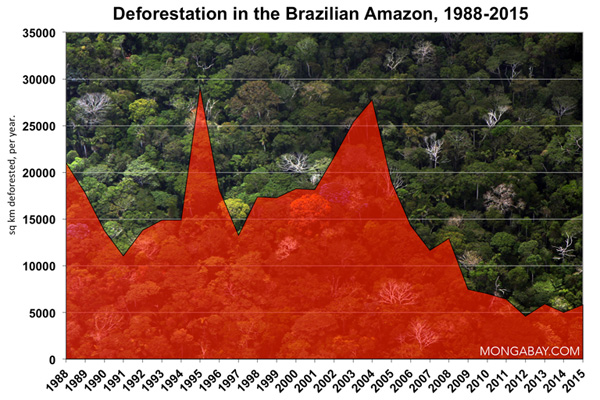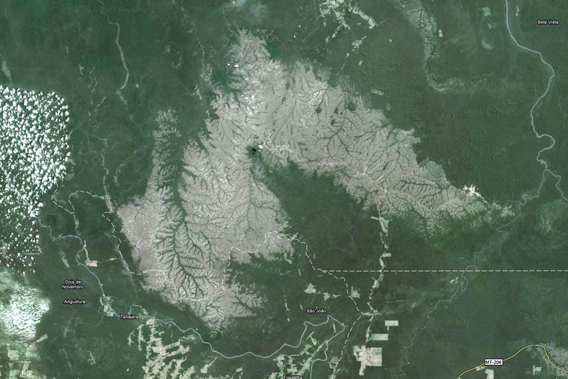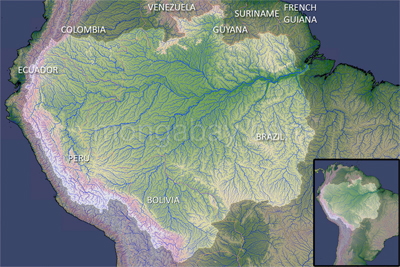
Deforestation in the Brazilian Amazon, 1988-2011. Photos by Rhett A. Butler.
Deforestation in the Brazilian Amazon fell to the lowest level on record between August 2010 and July 2011 according to preliminary data from Brazil’s National Institute of Space Research (INPE).
Forest clearing during the period amounted to 6,238 square kilometers (2,408 square miles), down about 10.9 percent from a year earlier when 7,000 square kilometers were chopped down. 78 percent of deforestation occurred in Pará, Mato Grosso, and Rondônia, the states where the bulk of agricultural expansion is concentrated.
The numbers are based on Brazil’s deforestation monitoring system called PRODES, which can detect clearing in patches down to 6.25 hectares (15.4 acres). The figures are preliminary — last year’s deforestation data was revised upwards 8.5 percent this past October.
The data shows deforestation continues to decline in the Brazilian Amazon, which accounts for more than 60 percent of the entire Amazon rainforest. Annual deforestation last peaked in 2003 and 2004 when more than 25,000 square kilometers of forest were destroyed in both years.
The Brazilian government says enforcement efforts, combined with conservation initiatives and sustainable development programs, have contributed to the decline, but analysts contend that macroeconomic trends, including a strong currency, which reduces profits for Brazilian commodity producers, play a bigger role. Research published in 2010 attributed 37 percent of the drop in deforestation between 2002 and 2009 in the Brazilian Amazon to new protected areas.
Brazil did not release data showing forest degradation, which can be an indicator of future deforestation.

Courtesy of Google Earth.
Forest Code vote
Brazil’s announcement came a day before the Senate planned to vote on a controversial bill that will revise the country’s Forest Code, which limits how much forest can be cleared on private lands. The revision, which has been pushed by agroindustrial interests, would grant amnesty for past illegal deforestation (up until mid-2008), while reducing requirements for legal forest reserves and setbacks along waterways. Green groups fear the changes could spur an immediate increase in deforestation.
But another threat looms large over Earth’s biggest rainforest: climate change. Scientists have repeatedly warned that higher temperatures in the tropical Atlantic will trigger rainfall shifts that leave much of the Amazon drier and more vulnerable to drought. And there are already signs these warnings should be heeded: in the past five years the Amazon experienced the two worst droughts ever recorded. Researchers say that deforestation and forest degradation will worsen the impacts of climate change by disrupting the hydrological functions of the forest. Such changes could have impacts on agricultural production in regions that currently rely on the Amazon for rainfall, including souther Brazil, Paraguay, and Argentina. Roughly 70 percent of South America’s GDP is produced in areas within the rain shadow of the Amazon.
Related articles
Deforestation and forest degradation slows in Brazil’s Amazon since August
(12/02/2011) Deforestation and forest degradation are down moderately from August through October 2011 relative to the same period a year ago, reports a satellite-based assessment released today by Imazon. Imazon’s near-real time system found that 512 sq km of rainforest were cleared between Aug 2011 and Oct 2011, the first three months of the deforestation calendar year, which runs from August 1 through July 31. The figure represents a 4 percent decline from the 533 sq km cleared in 2010
Concerns over deforestation may drive new approach to cattle ranching in the Amazon

(09/08/2009) While you’re browsing the mall for running shoes, the Amazon rainforest is probably the farthest thing from your mind. Perhaps it shouldn’t be. The globalization of commodity supply chains has created links between consumer products and distant ecosystems like the Amazon. Shoes sold in downtown Manhattan may have been assembled in Vietnam using leather supplied from a Brazilian processor that subcontracted to a rancher in the Amazon. But while demand for these products is currently driving environmental degradation, this connection may also hold the key to slowing the destruction of Earth’s largest rainforest.
How to save the Amazon rainforest
(01/04/2009) Environmentalists have long voiced concern over the vanishing Amazon rainforest, but they haven’t been particularly effective at slowing forest loss. In fact, despite the hundreds of millions of dollars in donor funds that have flowed into the region since 2000 and the establishment of more than 100 million hectares of protected areas since 2002, average annual deforestation rates have increased since the 1990s, peaking at 73,785 square kilometers (28,488 square miles) of forest loss between 2002 and 2004. With land prices fast appreciating, cattle ranching and industrial soy farms expanding, and billions of dollars’ worth of new infrastructure projects in the works, development pressure on the Amazon is expected to accelerate. Given these trends, it is apparent that conservation efforts alone will not determine the fate of the Amazon or other rainforests. Some argue that market measures, which value forests for the ecosystem services they provide as well as reward developers for environmental performance, will be the key to saving the Amazon from large-scale destruction. In the end it may be the very markets currently driving deforestation that save forests.
Future threats to the Amazon rainforest
(07/31/2008) Between June 2000 and June 2008, more than 150,000 square kilometers of rainforest were cleared in the Brazilian Amazon. While deforestation rates have slowed since 2004, forest loss is expected to continue for the foreseeable future. This is a look at past, current and potential future drivers of deforestation in the Brazilian Amazon.
